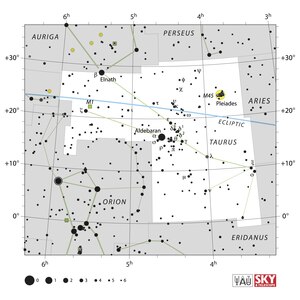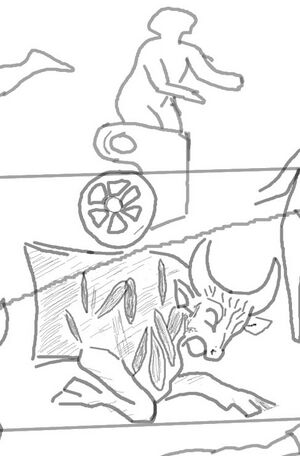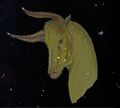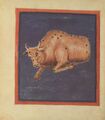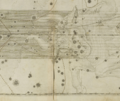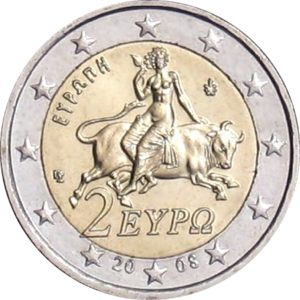Taurus
One of the 88 IAU constellations.
Etymology and History
The shape of a bull is quite easily recognisable in the sky in this asterism. Two open star clusters stand out prominently: the Hyades and the Pleiades. They are sometimes seen as the pillars of a gate through which the sun, moon and planets pass. By adding further stars, they become the figure of half a bull. Greek mythology explains the absence of the back of the bull by the fact that it is swimming.
In reality, of course, the zodiacal constellation - like all the others - is taken from Mesopotamia.
Origin of Constellation
Originally, the celestial bull is part of the Sumerian Epic of Gilgamesh. Gilgamesh was king of Sumer, the southern part of Mesopotamia, in the 3rd millennium. It is unclear how long this king actually lived and ruled, but he is documented in a list of kings. Perhaps several kings (of the same name) are mixed up there. The figure of Gilgamesh in literature symbolises a number of cultural upheavals or as a founder of culture.
The most important city in Sumer was Uruk, whose city goddess is Inanna/Ishtar. After Gilgamesh and his friend Enkidu had already performed other heroic deeds, they fight together in Uruk against the celestial bull sent by Ishtar: the bull belonged to Ishtar's father, the sky god Anu, and was therefore a deity or mythical creature. The heroes succeed in defeating the beast when Enkidu grabs the bull from behind and Gilgamesh grabs it from the front. This explains the bisected constellation.
Some researchers see the Mesopotamian constellations Hired Man (today: Aries) and True Shepherd of the Heavens (today: Orion) as a representation of this bullfight between Enkidu (Hired Man on the invisible hindquarters of the bull) and Gilgamesh. The figure of Orion stretches out one hand towards the bull's head and, according to the Almagest, swings a club with the other as if to hit the bull between the horns - as reported in the Epic of Gilgamesh (tablet 6). In addition, the shepherd figure (for humans) is a metaphor for rulers, which can be traced back to Sumerian times for kings and lives on today in the symbolism of Christian bishops. However, the divine shepherd is typically Dumuzi, Ishtar's husband, assigned to the labourer's constellation. The connection between the constellations Ori-Tau-Ari is therefore very speculative without written evidence. Writing as a cultural technique had only just been invented at this time. Only a few commercial documents and no astronomical texts have survived from the 3rd millennium.
Pleiades
The Pleiades are regarded - also in Mesopotamia - as seven stars. The origin of the number seven is unclear, but it can also be traced back to the 3rd millennium with the Epic of Gilgamesh. The standard name of the star in mathematical astronomy is a Sumerian loanword indicating an indefinite number of stars - loosely translated as ‘the star cluster’. In MUL.APIN, which is already written in Akkadian, only this Sumerian name is used, but later astronomical texts of the -1st millennium pass on ‘the bristle hairs’ of the bull as the Akkadian name. In MUL.APIN, where (almost) all celestial bodies are assigned to a deity, the Pleiades are associated with the so-called Seven Gods. These are seven sacred weapons that can speak and are perceived as deities. They are sometimes associated with the underworld. A relatively recently discovered fragment of the Gilgamesh Epic fits in with this, according to which seven underworld deities are the sons of Gilgamesh's first defeated opponent and the historical fact that before the earthly king Gilgamesh (with G) there was a god of the dead called Bilgamesh (with B). He was one of seven underworld gods before the myth of the king eclipsed this figure in importance. To summarise: We don't know, but a connection between the number seven and an early Sumerian death cult is obvious.
The Pleiades had several calendar functions:
Due to the different length of the solar year (365 days) and the lunar year (354 days), a leap month had to be inserted approximately every three years in Mesopotamia. Before these leap years could be set regularly, the rising of bright stars was consistently observed. The so-called Pleiades leap rule in MUL.APIN states that a month must be inserted as soon as the Pleiades rise at the beginning of the third month (heliacal), as they should normally do so in the second month. This switching rule was also handed down in the Arab world.
For the Phoenicians and Greeks, shipping between the numerous islands was of enormous importance. The Greeks therefore understood the name of the star ‘Pleias’ from πλέω (pleiu), meaning ‘to sail’, and Hesiod and Eratosthenes mention its significance as an indicator of the shipping season in the farming calendar.
The alternative name ‘Pleiades’ is also documented by Eratosthenes, who states: ‘One does not see seven stars, but only six.’ Greek mythology invents an unconvincing story of seven sisters, one of whom hid or left the group. Although the sisters have proper names in mythology, these names were not applied to the stars of the star cluster in ancient times. The modern naming is also confusing because two of the free-eyed stars were named after their parents, Pleione and Atlas.
Hyades
The V-shaped Hyades appear more scattered in the sky; in Mesopotamia they were regarded as the ‘jaws of Taurus’ and are interpreted in Greek as its face. The bright star Aldebaran, which physically does not belong to the star cluster but is (coincidentally) seen standing in the foreground in the same direction in the sky, had no proper name - neither in Mesopotamia nor in mathematical Greek astronomy. Only in his astrological work Tetrabiblos does Ptolemy give a name for the star: the torch. The modern name, Aldebaran, is Arabic and alludes to its position in the sky. The Pleiades rise first, followed by Aldebaran and the Hyades. Ad-Dabaran means ‘the following one’.
Greco-Roman
Aratos
Eratosthenes
Hipparchus
Geminos
Almagest Ταῦρος
| id | Greek
(Heiberg 1898) |
English
(Toomer 1984) |
ident. |
|---|---|---|---|
| Ταύρου ἀστερισμός | Constellation of Taurus | ||
| 1 | τῶν ἐν τῇ ἀποτομῇ δ’ ὁ βόρειος. | The northernmost of the 4 stars in the cut-off | 5 Tau |
| 2 | ὁ ἐχόμενος αὐτοῦ. | The one close by this | 4 Tau |
| 3 | ὁ ἔτι τούτου ἐχόμενος. | The one close again to the latter | xi Tau |
| 4 | ὁ ροτιώτατος τῶν δ | The southernmost of the 4 | omi Tau |
| 5 | ὁ τούτοις ἐπόμενος ἐπὶ τῆς δεξιᾶς ὡμοπλάτης | The one to the rear of these, on the right shoulder-blade | 30 Tau |
| 6 | ὁ ἐε τῷ στήθει | The star in the ehest | lam Tau |
| 7 | ὁ ἐπὶ τοῦ δεξιοῦ γόρατος | The star on the right knee | mu Tau |
| 8 | ὁ ἐπὶ τοῦ δεξιοῦ σφυροῦ | The star on the right hock | nu Tau |
| 9 | ὁ ἐπὶ τοῦ ἀριστεροῦ γόνατος | The star an the left knee | 90 Tau |
| 10 | ὁ ἐπὶ τοῦ ἀριστεροῦ πήχεως | The star on the left lower leg | 88 Tau |
| 11 | τῶν ἐν τῷ προσώπῳ καλουμένων Τάδων ὁ ἐπὶ τῶν μυκτήρων | The stars in the face, called 'the Hyades': the one on the nostrils | gam Tau |
| 12 | ὁ μεταξὺ τούτου καὶ τοῦ βορεύου ὀφθαλμοῦ | The stars in the face, called 'the Hyades': the one between this and the northern eye | del1 Tau |
| 13 | ὁ μεταξὺ αὐτοῦ καὶ τοῦ φοτύου ὀφδαλμοῦ | The stars in the face, called 'the Hyades': the one between it [ no. 11] and the southern eye | tet1 Tau |
| 14 | ὁ λαμπρὸς τῶν Ῥάδων ἐπὶ τοῦ νοτίου ὀφθαλμοῦ ὑπόκιρρος | The stars in the face, called 'the Hyades': the bright star ofthe Hyades, the reddishone on the southern eye | alf Tau |
| 15 | ὁ λοιπὸς καὶ ἐπὶ τοῦ βορεύου ὀφθαλμοῦ | The stars in the face, called 'the Hyades': the remaining one, on the nordlern eye | eps Tau |
| 16 | ὁ ἐπὶ τῆς ἐκφύσεως τοῦ νοτίου κέρατος καὶ τοῦ ὠτίου | The star on the place where the southern horn and the ear join [the head] | 97 Tau |
| 17 | ὁ τῶν ἐπὶ τοῦ φοτίου κέρατος β ὁ νοτιώτερος | The southernmost of the 2 stars on the southern horn | 104 Tau |
| 18 | ὁ βορειότερος αὐτῶν | The northernmost of these | 106 Tau |
| 19 | ὁ ἐπ’ ἄκρου τοῦ νοτίου κέρατος | The star on the tip of the southern horn | zet Tau |
| 20 | ὁ ἐπὶ τῆς ἐκφύσεως τοῦ βορείου κέρατος. | The star on the place where the northern horn joins [ the head] | tau Tau |
| 21 | ὁ ἐπ’ ἄκρου τοῦ βορείου κέρατος ὁ αὐτὸς τῷ ἐπὶ τοῦ δεξιοῦ ποδὸς τοῦ Ἡνιόχου. | The star on the tip of the northern horn, which is the same as the one on right foot of Auriga | bet Tau |
| 22 | τῶν ἐν τῷ βορείῳ ὠτίῳ β σύνεγγυς ὁ βορειότερος | The northernmost of the 2 stars close tagether in the northern ear | ups Tau |
| 23 | ὁ νοτιώτερος αὐτῶν. | The southernmost of them | kap Tau |
| 24 | τῶν ἐν τῷ τραχήλῳ β μικρῶν ὁ προηγούμενος | The more advanced of the 2 small stars in the neck | 37 Tau |
| 25 | ὁ ἐπόμενος αὐτῶν | The rearmost of them | omega Tau |
| 26 | τοῦ ἐν τῷ αὐχένι τετραπλεύρου τῆς προηγουμένης πλευρᾶς ὁ νοτιώτερος | The quadrilateral in the neck: the southernmost star on the advance side | 44 Tau |
| 27 | ὁ βορειότερος τῆς προηγουμένης πλευρᾶς | The quadrilateral in the neck: the northernmost star on the advance side | psi Tau |
| 28 | τῆς ἐπομένης πλευρᾶς ὁ νοτιώτερος | The quadrilateral in the neck: the southernmost star on the rear side | chi Tau |
| 29 | ὁ βορειότερος τῆς ἐπομένης πλευρᾶς. | The quadrilateral in the neck: the northernmost one on the rear side | phi Tau |
| 30 | τῆς Πλειάδος τὸ βόρειου πέρας τῆς ἠγουμένης πλευρᾶς | The Pleiades: the northern end of the advance side | 19 Tau |
| 31 | τὸ νότιον πέρας τῆς ἠγουμένης πλευρᾶς | The Pleiades: the southern end of the advance side | 23 Tau |
| 32 | τὸ ἐπόμενου καὶ στεηότατον πέρας τῆς Πλειάδος. | The Pleiades: the rearmost and narrowest end of the Pleiades | 27 Tau |
| 33 | ὁ ἔκτος καὶ μικρὸς τῆς Πλειάδος ἀπ’ ἄρκτων | The Pleiades: the small star outside the Pleiades, towards the north | HR 1188 |
| ἀστέρες λβ, ὥν αἱ μεγέθουςα, γ’ς, δ’ ἴἄ, ε φ, ς’ α. | 32 stars, 1 of the first magnitude, 6 of the third, 11 of the fourth, 13 of the ftfth, 1 of the sixth | ||
| Οἱ περὶ τὸν Ταῦρον ἀμόρφωτου. | Stars araund Taurus outside the constellation: | ||
| 34 | ὁ ὑπὸ τὸν δεξιὸν πόδα καὶ τὴν ὡμοπλάτην. | The star under the right foot and the shoulder-blade | 10 Tau |
| 35 | τῶν ὑπὲρ τὸ νότιον κέρας γ’ ὁ προηγούμενος. | The most advanced of the 3 stars over the southern horn | iot Tau |
| 36 | ὁ μέσος τῶν τριῶν. | The middle one of the three | 109 Tau |
| 37 | ὁ ἐπόμενος αὐτῶν. | The rearmost of them | 114 Tau |
| 38 | τῶν ὑπὸ τὸ ἄκρου τοῦ νοτίου κέρατος β’ ὁ βορειότερος. | The northernmost of the 2 stars under the tip of the southern horn | 126 Tau |
| 39 | ὁ νοτιώτερος αὐτῶν. | The southernmost of them | 129 Tau |
| 40 | τῶν ὑπὸ τὸ βόρειον κέρας ἓ ἐπομένων ὁ προηγούμενος. | The 5 Stars under and to the rear of the northern horn: the most advanced | 121 Tau |
| 41 | ὁ τούτῳ ἑπόμενος. | The 5 Stars under and to the rear of the northern horn: the one to the rcar of thi's | 125 Tau |
| 42 | ὁ ἔτι τούτῳ ἐπόμενος. | The 5 Stars under and to the rear of the northern horn: the one to the rear again of the latter | 132 Tau |
| 43 | τῶν λοιπῶν καὶ ἐπομένωυ β ὁ βορειότερος. | The 5 Stars under and to the rear of the northern horn: the northernmost of the remaining, rearmost 2 | 136 Tau |
| 44 | ὁ νοτιώτερος αὐτῶν. | The 5 Stars under and to the rear of the northern horn: the southernmost of these two | 139 Tau |
| ἀστέρες ιὰ, ὧν δ’ μεγέθους ἄ, 8 ἱ. | {ll stars, I of the fourth magnitude, I 0 of the fifth} |
Transfer and Transformation of the Constellation
Greek Mythology
The most famous of the Greek myths about the bull is the abduction of Princess Europa of Phoenicia. Zeus had transformed himself into a bull, she played with him, sat on his back and then he galloped into the water and swam to Crete. Euripides tells this story and also found its way into astronomical literature via Eratosthenes. Today, the motif is depicted on Greek 2 euro coins.
Mythographers favour the Pleiades story of the nymph Pleione and her seven daughters, who supposedly want to remain virgins but are pursued by the lustful Orion. They apparently do not achieve their goal of eternal virginity, because each of them becomes pregnant: none by Orion. Six of them give birth to sons of the gods, one of them - Merope - marries the mortal Sisyphus (from the Greek ‘merops’, mortal).
In Mesopotamia, the Celestial Bull is undoubtedly from the Epic of Gilgamesh:
Gilgamesh was a cruel ruler under whom his subjects suffered. The gods therefore created a companion for him. This one, Enkidu, had grown up among animals and represents the moral antithesis to Gilgamesh: He criticises the ruler's cruelty. After a wrestling match, they become friends and set off together to cut down trees in the sacred cedar forest. First they have to defeat the guardian of this forest, which they succeed in doing, but afterwards Enkidu regrets the deed because the forest is no longer so beautiful and is inhabited and ‘animated’ by animals. Next they come to Uruk, where the city goddess offers Gilgamesh to become her husband. He refuses, pointing out that her other suitors have fared badly. Ishtar then complains to her father Anu and asks him for the Bull of Heaven to set him on Gilgamesh, who has insulted her. Anu points out that the city of Uruk and its inhabitants are threatened with great famine if he is brought down to earth, but Ishtar says that she has made provisions for the people. Nevertheless, 300 men fall victim to this bull before Enkidu and Gilgamesh slaughter it and sacrifice it to the sun god.
Enkidu must atone for this deed with death and Gilgamesh, who initially sets out in search of the herb of life for immortality, finally realises that there are more important things than power and violence and that immortality can only be achieved through good deeds. He invents the city wall to pacify Uruk and becomes a good king.
A bull associated with the sun is a fairly common religious motif: it also appears in the contemporary Egyptian deity Apis and later in the cult of Mithras.
Weblinks
- Ridpath, Ian, “Star Tales: online edition”.
